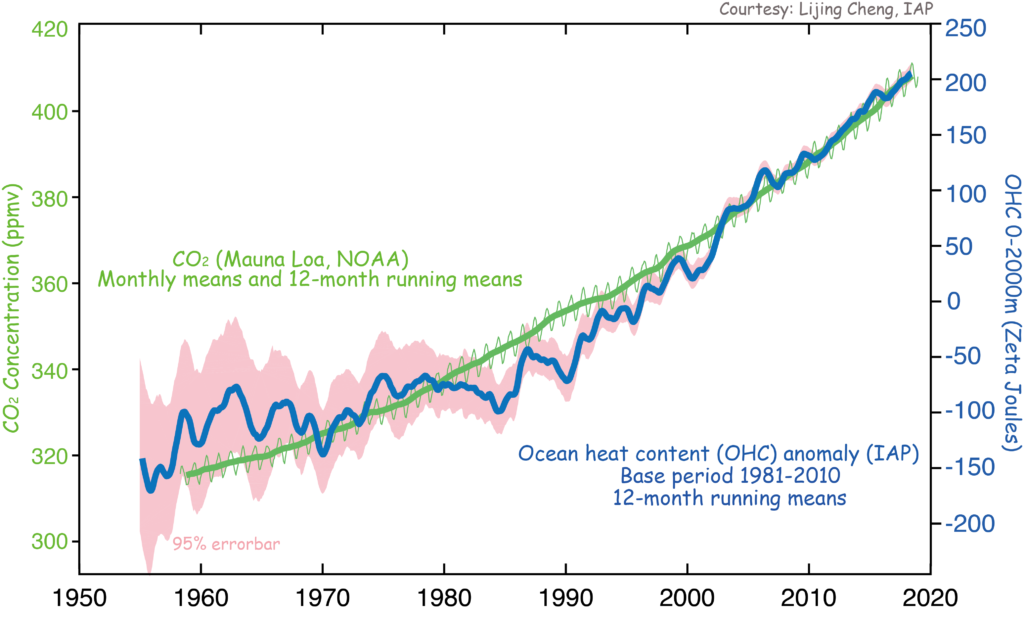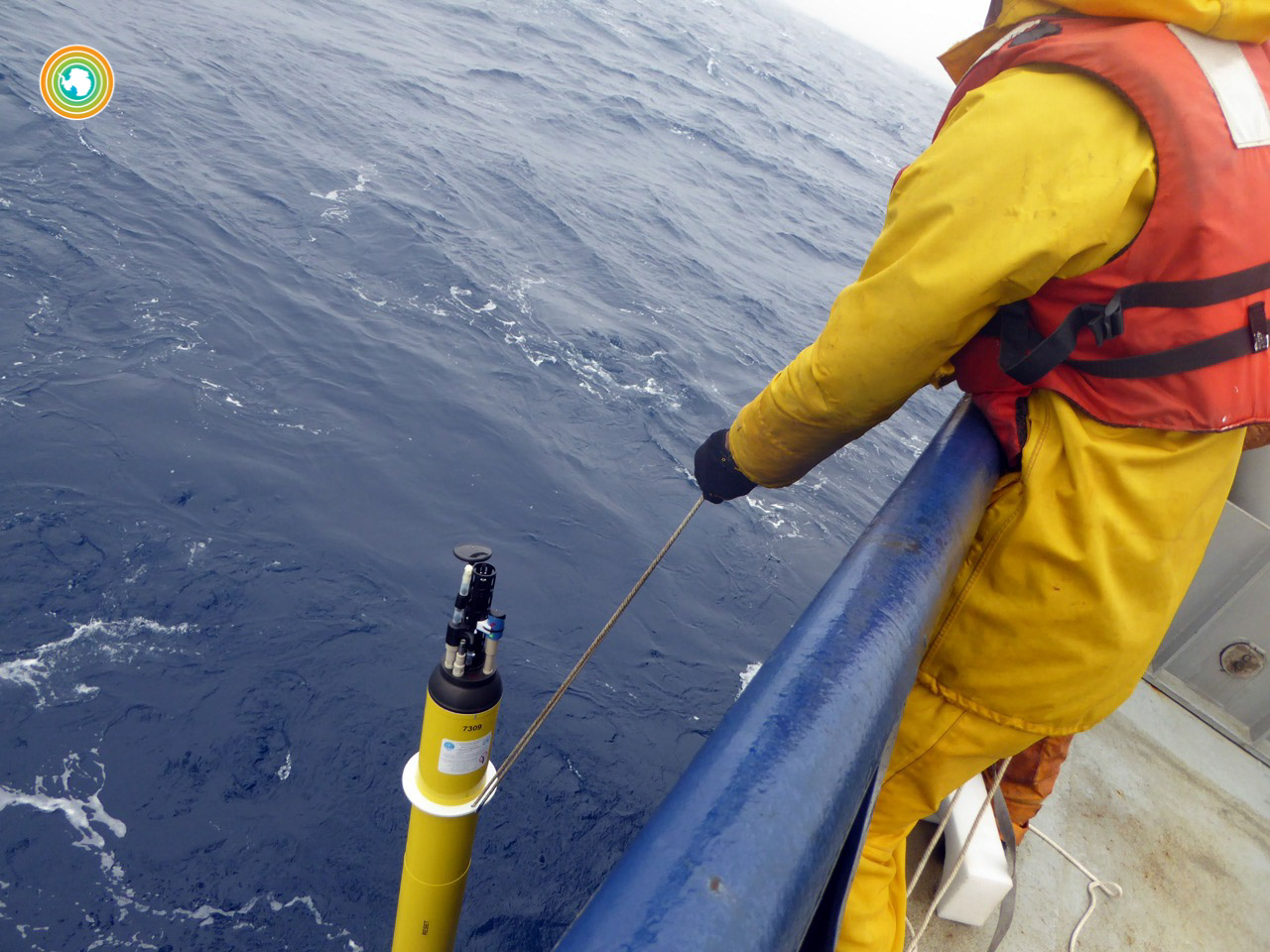Observations and models agree that the oceans are warming faster
Posted on 14 January 2019 by Zeke Hausfather
This is a re-post from Carbon Brief. Dr Lijing Cheng is an associate professor at the Institute of Atmospheric Physics in China; Prof John Abraham is a professor in the School of Engineering at the University of St. Thomas; Zeke Hausfather is the US analyst for Carbon Brief; and Dr Kevin Trenberth is a senior scientist at the National Center for Atmospheric Research.
Ocean heat content (OHC) is one of the main measures of climate change, with around 93% of all heat trapped by greenhouse gases in the atmosphere accumulating in the Earth’s oceans.
The “fingerprint” of human influence on the climate is much easier to detect in the oceans, as it is much less affected by year-to-year natural variability than more commonly used surface temperature records.
Back in 2013, the IPCC Fifth Assessment Report (AR5) identified a discrepancy between climate models and observations of OHC, where the oceans appeared to be warming notably more slowly than most models projected.
However, over the past five years the research community has made substantial progress in improving long-term OHC records and has identified several problems with prior OHC estimates. Improvements include properly accounting for limitations in some older OHC instruments and taking advantage of better methods of accounting for gaps in the coverage and completeness of ocean temperature measurements.
In a new “perspectives” paper for the journal Science, we show that these updated OHC estimates agree well with climate model projections over the past few decades. This means that scientists can have more confidence in climate model simulations of OHC changes now and into the future.

Ocean heat content from Cheng et al 2017 in zetajoules (10^21 joules) compared to atmospheric CO2 concentrations in parts per million.
Recent records show more warming
OHC is a record of the heat content of the Earth’s oceans. It is generally given for a range of depths from 0-700 metres or 0-2000 metres, as historical measurements below 2000 metres are extremely sparse.
The majority of the heat trapped by greenhouse gases in the atmosphere over the past century – over 65% – has accumulated in the top 700 metres of the ocean, with most of the remainder in the top 2000 metres. OHC is a different metric from sea surface temperatures, which only measure the top metre or so of the ocean and more closely match changes in air temperatures.
OHC is challenging to measure. However, since the mid-2000s, scientists have had the benefits of a network of thousands of autonomous robots – called Argo floats – that dive down to depths of 2000 metres or so and measure temperature, salinity, pH and other ocean characteristics as they slowly ascend. Once the Argo floats surface, the data they have collected is relayed back to scientists by satellite. The collated data is freely available for anyone to download and use.

Researchers deploying an Argo float. Credit: Cara Nissen.
Prior to the mid-2000s, measurements were much less frequent and used devices called “expendable bathythermographs” (XBTs) – a temperature probe connected by wire to a ship, which sinks down into the ocean until the wire runs out and the probe is lost – that required extensive calibration to produce a consistent record.
XBTs are problematic in that they do not measure the depth at which they take temperatures. Using them for OHC estimates requires assumptions around the rate of both horizontal and vertical movement in the ocean. Differing corrections to XBT measurements, as well as different approaches to infilling regions where data is sparse, have led to large differences in OHC estimates prior to the Argo era.
In our article, published in Science, we analyse a number of OHC records published by different groups. We examine the five records included in AR5, as well as four new or updated records that have been published over the past few years.
The figure below shows the rate of OHC warming in these records, as well as the rate projected by the climate models featured in AR5 (collectively known as “CMIP5”). The rate of warming is shown for the 1971-2010 period highlighted in AR5; estimates in blue were included in AR5, while those in purple were published more recently. The range of OHC warming across all the CMIP5 models is shown in grey.
Rate of ocean heat content warming for the top 2000 meters of the ocean, from 1971-2010, in zetajoules (10^21 joules) per year. For each study the bar shows the 90% trend uncertainty, with the mean estimate shown by the black dot in the middle. For CMIP5 models, the bar spans the 90% range of models, with the black dot showing the multi-model mean. Data available here.
OHC records published in recent years show, on average, about 40% – with a range of 15% to 100% – more warming than the OHC records featured in AR5.
These three new records have been corrected for issues that were identified in data collected from XBTs. They also employ better statistical methods to account for limited coverage of data sampling for OHC, particularly prior to the Argo era.
A fourth new study by Prof Laure Resplandy of Princeton University and colleagues used a novel approach of estimating changes in OHC based on the amount of oxygen and CO2 being released by the oceans. Their data is not included in the chart above because they only provide estimates after 1991 due to a lack of measurements prior to that point.
However, their best estimate – after recent corrections to their methods – agrees quite well with other recent studies, despite their uncertainties being quite large.
The figure below shows the change in OHC over time in all four new studies, and compares them with the range of OHC changes across the CMIP5 models (grey band). The average of all the models is shown by the black line. The climate models and observations are plotted with respect to a 1981-2010 baselines, which results in model uncertainties that expand both before and after the baseline period.
Change in ocean heat content – in zetajoules – for the top 2000 meters of the ocean with respect to a 1981-2010 baseline period in CMIP5 climate models (black line is the multimodel mean, grey area represents the 95th percentile range of model runs; RCP8.5 runs are used after historical runs end in 2005) and recent observational records (coloured lines). Data available here.
As with the earlier chart, these new records agree well with climate model projections over the past few decades, resolving the apparent discrepancy between CMIP5 models and the OHC observations featured in the IPCC AR5.
That four independent groups of researchers have all found similar results for OHC in recent years makes us more confident that these results are accurate – and that prior OHC records suffered from problems that led them to systematically underestimate OHC changes.
The agreement between climate model projections and OHC observations over the past few decades also gives us confidence that climate models are able to reliably project OHC changes into the future.
References:
Cheng, L. et al. (2018). How fast are the oceans warming? Observational records of ocean heat content show that ocean warming is accelerating. Science. doi.org/10.1126/science.aav7619
Domingues, C. M. et al. (2008). Improved estimates of upper-ocean warming and multi-decadal sea-level rise, Nature. doi.org/10.1038/nature07080
Cheng, L. et al. (2017). Improved estimates of ocean heat content from 1960 to 2015. Science Advances. doi.org/10.1126/sciadv.1601545M
Ishii, M. et al. (2017). Accuracy of global upper ocean heat content estimation expected from present observational data sets. SOLA. doi.org/10.2151/sola.2017-030
Resplandy, L. et al. (2018). Quantification of ocean heat uptake from changes in atmospheric O2 and CO2 composition. Nature. doi.org/10.1038/s41586-018-0651-8































 Arguments
Arguments






























Comments